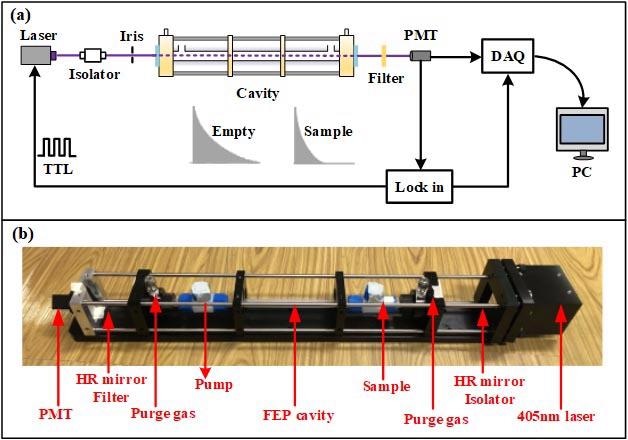A unique detection technology that can realize rapid and sensitive detection of nitrogen dioxide (NO2) was created by a research team guided by Prof. ZHANG Weijun from Hefei Institutes of Physical Science (HFIPS), Chinese Academy of Sciences (CAS) recently.
 Schematic diagram of the experimental setup of the AM-CEAS instrument. (Image Credit: ZHOU Jiacheng).
Schematic diagram of the experimental setup of the AM-CEAS instrument. (Image Credit: ZHOU Jiacheng).
The relevant results from the study have been reported in the journal Analytical Chemistry.
NO2 is one of the most significant pollutants in the troposphere and has a very crucial role to play in the process of atmospheric pollution. Therefore, very sensitive and accurate measurements of NO2 are of major importance to research on atmospheric chemistry and air pollution prevention and control.
In this study, for the first time, researchers applied the amplitude modulation method to a multimode diode laser and created an Amplitude Modulated multimode-diode-laser-based Cavity Enhanced Absorption Spectroscopy (AM-CEAS) system for highly sensitive NO2 detection.
The new instrument TTL-controlled at 35 kHz was worked at 406 nm, employing phase-sensitive detection for ultra-sensitive absorption measurement. The detection precision rates of the instrument were 35 pptv and 8 pptv, respectively, in 1 second and 30 seconds data acquisition time, more than 4 times lower than what was accomplished with the Cavity Ring-Down Spectroscopy (CRDS) technique using the same instrument.
Integrating with ring-down time measurement, the AM-CEAS technique can remove the calibration process of mirror reflectivity, thereby accomplishing NO2 absolute concentration measurements. It also has the benefits of high injection efficiency such as on-axis alignment CRDS, low cavity-mode noise such as off-axis alignment CEAS, and phase-sensitive detection of modulation spectroscopy.
The AM-CEAS instrument is a basic, reliable, economical, self-calibration tool ideal for long-standing stability and low maintenance requirements, which has a favorable prospect in scientific exploration and operational application.
The recently developed instrument is undergoing wide-ranging field observation at an urban site of Beijing and is used for calculating the total reactive nitrogen in the air during the Beijing 2022 Olympic Winter Games.
This study received support from the National Natural Science Foundation of China, the Second Tibetan Plateau Scientific Expedition and Research program, the Youth Innovation Promotion Association CAS, the Instrument Developing Project of the Chinese Academy of Sciences, and the HFIPS Director’s Fund.
Journal Reference:
Zhou, J., et al. (2022) Amplitude-Modulated Cavity-Enhanced Absorption Spectroscopy with Phase-Sensitive Detection: A New Approach Applied to the Fast and Sensitive Detection of NO2. Analytical Chemistry. doi.org/10.1021/acs.analchem.1c05484.